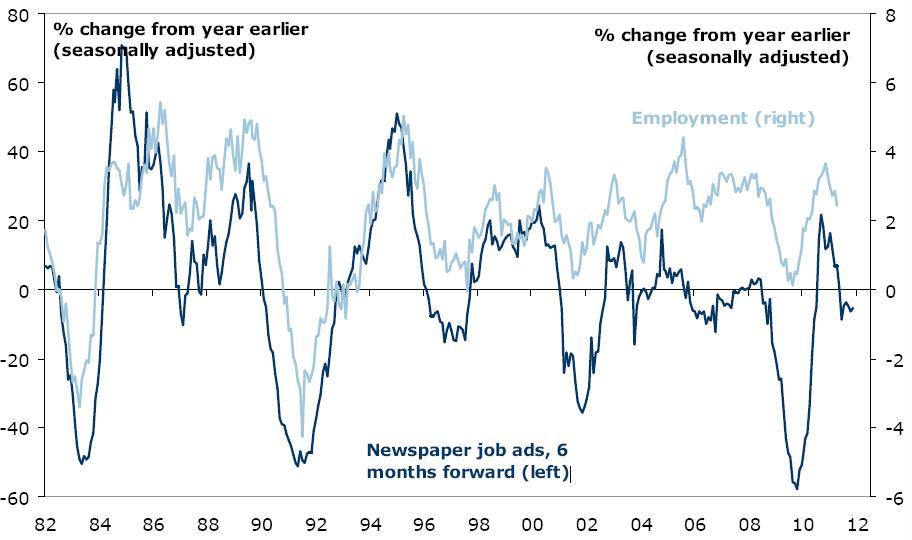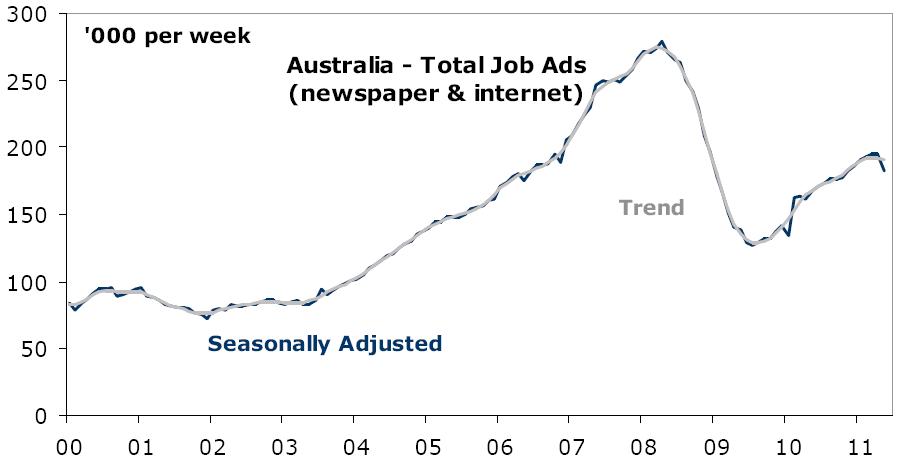
ANZ job ads for May are out and got thumped. As usual, the accompanying commentary comes with the rhetoric of boom ahead. I think it’s about time we called this what it is: Futureboom. The worse the data, the bigger the Futureboom, it seems:
Total job advertisements on the internet and in newspapers decreased by 6.5% inMay to be 8.3% higher than a year earlier.
• Newspaper job ads fell by 2.7%, while internet job advertising declined by 6.6%.Newspaper advertising has now fallen for three consecutive months, while internetadvertising has fallen for two consecutive months.
• In trend terms, total job ads fell by 0.5% in May with the annual growth rate slowingto 13.5%.
ANZ Chief Economist Warren Hogan said:
• Job advertising fell in May, with advertising in April downwardly revised to amonthly fall of 0.4%. This is the first time we have seen two consecutive monthsof negative job advertising since July 2009. The slowing in job advertisement growth in 2011 thus far has been broadly in line with slowing in employment growth.
• The annual rate of growth of job ads has slowed over the past six months and is now just 8.5% above year ago levels. Newspaper ads are 5.2% lower than a yearago. We have seen many monthly economic indicators impacted by seasonalfactors related to ANZAC day and Easter falling closely together this year. Wesuspect the recent dip in job advertising could be overstated because of this.
• Job advertising in May was broadly in line with November 2010 levels. Similarly,the unemployment rate in April 2011 has remained broadly in line with December2010 levels at 4.9%. Recent trends in the job ads series indicate a stable labourmarket for the next three to six months or so with unemployment likely to hoveraround 4.75% to 5%.
• Recent stronger investment spending data in Q1 combined with very robustinvestment intentions suggest to us that the labour market will strengthen later inthe year as capital investment picks up. We expect the unemployment rate togradually trend down over the year ahead.
• ANZ is forecasting an increase of 14,000 jobs in May which we expect will leavethe unemployment rate at 4.9%.• Newspaper job advertising has been soft across most of the states of Australia.NSW and the Northern Territory have the strongest newspaper job advertisingmarkets in 2011. Looking forward, evidence of the multi-speed economy is likelyto become more pronounced as the investment boom gets underway over thenext two years. We would expect Western Australia, Queensland and New SouthWales to experience the strongest labour markets.
• With the unemployment rate below 5% and likely to remain that way or headlower over the next year, the Reserve Bank will maintain a strong tightening biasin it’s monetary policy. We expect a further 25bp increase in the RBA cash rateover the next three months in response to tightening labour market conditionsand rising inflation pressures.
Total job advertisements
The ANZ Job Advertisements Series shows the total number of jobs advertised in major metropolitan newspapers and on the internet fell by 6.5% in May to an average of 182,087 advertisements per week (seasonally adjusted). This follows a 0.4% decrease in April.The number of job advertisements is now 8.3% higher than a year ago, a deceleration from the previous month. The annual rate of growth in job advertising is now below its long-term trend of 10.7%. The total number of job ads remains 34.8% below the all-time peak achieved in April 2008. This suggests that the labour market is not yet as tight as it was at the height of the first phase of the commodity boom.
In trend terms, growth in job advertisements fell by 0.5% in May. This follows a slight fall of 0.1% in April. Monthly trend growth in total job ads has now been slowing since January 2011. In annual terms, trend growth in total job advertisements eased to 13.5% in May after reaching a near six-year high of 36.2% in September 2010 (see Table 1).Newspaper job advertisements
The number of job advertisements in major metropolitan newspapers fell by 2.7% in May to be 5.3% lower than year ago (see Table 2). The seasonally adjusted weekly average number of job advertisements was 8,837 in May. This was 10.3% lower than the recent peak of 9,856 in March 2010. While some of the fall in newspaper job advertisements can be attributed to a trend shift toward internet advertisements, we have now seen the total number of job advertisements fall for two consecutive months.In trend terms, the number of newspaper job advertisements fell 0.7% in May and was 4.8% lower than a year ago.
In May, newspaper job advertisements rose in the Northern Territory (+8.4% m/m), South Australia (+2.0% m/m) and the ACT (+1.9% m/m). Newspaper job ads fell in Victoria (-5.4% m/m), New South Wales (-4.1% m/m), Western Australia (-3.6% m/m) and Tasmania (-3.4% m/m). Queensland also experienced a decline (-0.8%), although the level of newspaper job advertisements in Queensland is still well above the pre-flood level in December 2010 (see Table 3).
Internet job advertisements
The number of internet job advertisements fell by 6.6% in May. This is broadly in line with November 2010 levels. Internet job advertisements are now 9.1% higher than a year ago. In trend terms, internet job advertisements fell by 0.5% in May to be 14.6% higher than a year earlier (see Table 4). Annual trend growth in internet job ads has continued to slow in 2011, albeit from a considerably high growth rate post the GFC.
Make sure you scroll to the end. There are some great charts. The first charts the correlation between job ads and employment growth:

ANZ have moved the darker blue line of jobs ads forward six months to show the relationshisp but that also suggests that change in the growth rate of ads lead employment growth by six months or so.
I’m especially fond of the following:

There’s a beautiful symmetry between the 05-07 and the 09-11 periods. Followed by a bang in the first, and whimper in the second. We might call this chart “boom averted”. Although I think it unlikely, what a shocker it would be if a slowing US were to drag the world towards recession now…Futureboom may never be!

